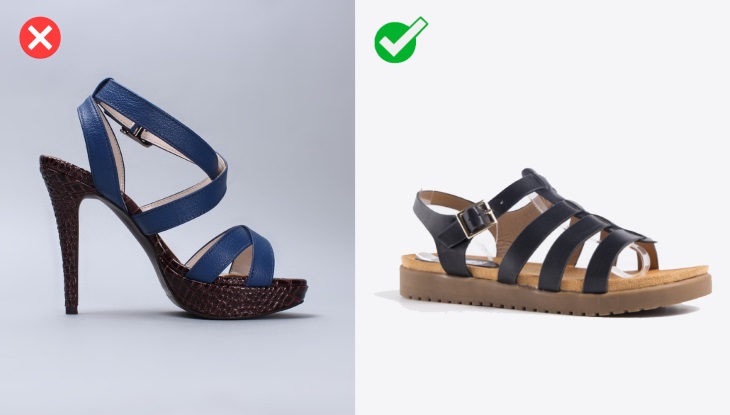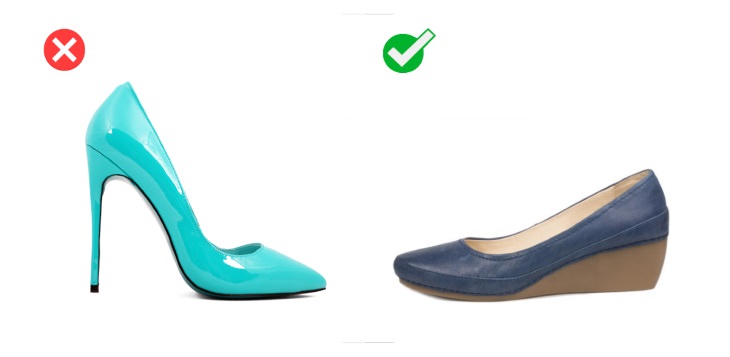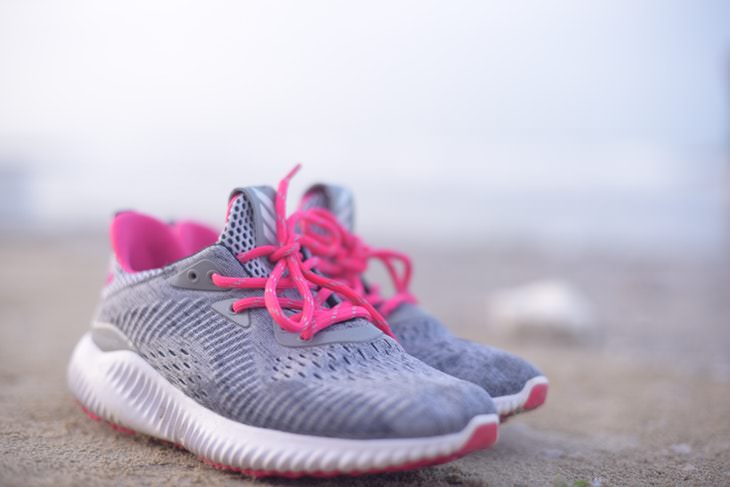How To Choose the Safest Footwear For Warm Weather
The
onset of the long-awaited warm sunny weather is a chance to bust out
all the footwear that sat and waited patiently somewhere in a shoe box
all year just to be worn again this season. This is also the perfect
time to go shopping for new footwear. In either scenario, you are
risking to end up with a problem on your hands, as a lot of the shoes we
so commonly associate with summer take a toll on our tender and
vulnerable feet, with flip flops being one of the most dangerous of the
bunch. To aid you on this quest for the safest footwear, we wrote this
entire article dedicated to the Dos and Don’ts of summer footwear.
1. Don’t wear them for more than 3 hours daily.
2. When you do wear flip flops, don't miss the tops of the feet when applying sunscreen, as this area is prone to burning.
3. Take breaks when you have to walk for more than 30 minutes in flip flops.
4. Only wear flip flops when they are necessary, e.g. at the beach or at the swimming pool.
5. Opt for more closely-fitted flip flops that adhere better to the foot, as these will not hit your heels so much and will be more comfortable. If you can find one, get a pair with arch support.

1. Flip Flops
Flip
flops are easy to put on and take off, and they are usually
manufactured from water-resistant materials that make them durable,
especially when worn at the beach. This is why putting on a pair of
flips flops at the beach or on a picnic is acceptable. However, wearing
flip flops for extensive periods of time (more than 1-3 hours every
day) can harm your health. Here’s how:
- It can exacerbate existing problems, such as cracked heels, athlete’s foot, and calluses.
- Walking in flip flops for extensive periods of time is more tiring than any other footwear, as they don’t adhere well to the foot and don’t have any heels and arch support.
- Prolonged wear of flip flops can cause blistering between the toes.
- Flip flops are especially
prone to cause a condition called plantar fasciitis, which is the
overstretching, inflammation and tearing of the fascia in the bottom of
your feet that can occur as the result of walking barefoot or in
ill-fitting shoes.
- Finally, flip flops don’t protect the foot from any injuries and sunburns, so they are ill-suited for any sports activities, hiking trips, or even a barbecue.
1. Don’t wear them for more than 3 hours daily.
2. When you do wear flip flops, don't miss the tops of the feet when applying sunscreen, as this area is prone to burning.
3. Take breaks when you have to walk for more than 30 minutes in flip flops.
4. Only wear flip flops when they are necessary, e.g. at the beach or at the swimming pool.
5. Opt for more closely-fitted flip flops that adhere better to the foot, as these will not hit your heels so much and will be more comfortable. If you can find one, get a pair with arch support.
2. Casual Shoes (such as Ballet Flats, Converse, Plimsolls)
All of these flat shoes are
quite popular in the summertime, as they are breathable, offer more
protection and yet easy to keep on, unlike flip flops. However, even
these shoes can be harmful to your posture and health, here’s how:
- Flat shoes often lack heel and arch support, which can potentially cause pathological alterations in posture, knee pain, etc.
- The cheaper varieties are often not very breathable and can make your feet sweat in the summer. This warm and humid environment, in turn, can promote the spread of bacteria and fungi, which can cause anything starting from smelly feet to fungal infections.
3. Sandals

If you’re looking for a pair of
open footwear that will be both extremely breathable, fitted, and
provide support to the feet, sandals are your best bet. And while they
still are not suited for hiking trips, as they don’t offer enough
protection for the feet, they are a great choice for long city walks and
other outdoor activities. Furthermore, they are often made of natural
materials that don’t make your feet sweaty. Here is what you should be
aware of when wearing sandals:
1. Sandals can be very different. The soles of some sandals are too flat and thin, which creates the same kind of repercussions as any other flat footwear: painful, tired feet and bad posture. That’s why it is recommended to choose a pair with a thicker sole and supported arch.
2. Choose a pair that will be adjustable to make sure they adhere to the feet, otherwise they’re no better than flip flops.
3. Opt for natural materials that breathe and prevent your feet from sweating.
4. When choosing a heeled sandal, don’t go higher than 2 inches (5 cm) and look for a chunky heel or platform.
1. Don’t get shoes with a heel higher than 2 inches.
2. Opt for a chunky heel or platform and not a stiletto, which will provide more support.
3. Don’t buy a pair of heels that isn’t comfortable or stable, no matter how gorgeous they might look. Uncomfortable heels are more likely to cause toe injuries and sprained ankles.
4. Wear your high-heeled shoes in before wearing them out. Although this is true about most shoes, heels can be particularly ruthless in causing blisters, so make sure to wear them around the house before wearing them outdoors.
FOR
CROCHET DESIGNS
https://gscrochetdesigns.blogspot.com
1. Sandals can be very different. The soles of some sandals are too flat and thin, which creates the same kind of repercussions as any other flat footwear: painful, tired feet and bad posture. That’s why it is recommended to choose a pair with a thicker sole and supported arch.
2. Choose a pair that will be adjustable to make sure they adhere to the feet, otherwise they’re no better than flip flops.
3. Opt for natural materials that breathe and prevent your feet from sweating.
4. When choosing a heeled sandal, don’t go higher than 2 inches (5 cm) and look for a chunky heel or platform.
4. High-Heeled Shoes
In
this category we included stilettos, platform shoes, pumps in a variety
of styles, materials and shapes. When the heel is higher than 2 inches
(5 cm), this can cause a variety of problems, such as:
- The so-called pump bump, which is a bony protrusion at your heel that feels like a callus. These can be very painful and are, unfortunately, chronic.
- When wearing high heels, you
carry most of your weight on your toes and the ball joints of your feet,
which is a very unnatural posture, as usually the weight is evenly
distributed throughout the foot. This can cause pain and injuries in the
front part of the feet.
- Those who wear high-heeled shoes are more likely to get ankle sprains, which can either stretch out or, in more severe cases, tear the ligaments in the ankle joint.
1. Don’t get shoes with a heel higher than 2 inches.
2. Opt for a chunky heel or platform and not a stiletto, which will provide more support.
3. Don’t buy a pair of heels that isn’t comfortable or stable, no matter how gorgeous they might look. Uncomfortable heels are more likely to cause toe injuries and sprained ankles.
4. Wear your high-heeled shoes in before wearing them out. Although this is true about most shoes, heels can be particularly ruthless in causing blisters, so make sure to wear them around the house before wearing them outdoors.
5. Sneakers and Tennis Shoes
The last item on our list is
probably the ultimate footwear. It’s breathable, lightweight, provides
ample protection, supports the arches of the feet, and can be easily
adjusted. It is suitable to most types of activities and doesn’t exert
the feet. But even these, seemingly-perfect shoes can potentially be
harmful to your feet.
1. For one, bad quality sneakers are often not breathable enough and can exacerbate athletes foot and bacterial infections, so choose a pair that is breathable.
2. Even the best quality sneakers can make your feet sweaty, so make sure to wear a different pair every day to let them vent.
3. Rocker bottom sneakers are a popular trend and they can help strengthen the muscles in your feet, but they are not advised for seniors, as they can affect muscle strength or balance.
4. Don’t choose a shoe that is too tight-fitting or loose around the toe box, as this, too, can affect the distribution of weight throughout the feet. A very tight shoe box, for example, may even cause numbness and pain in the toes, so it is important to wear a pair of sneakers or tennis shoes that will fit your size and foot shape.
1. For one, bad quality sneakers are often not breathable enough and can exacerbate athletes foot and bacterial infections, so choose a pair that is breathable.
2. Even the best quality sneakers can make your feet sweaty, so make sure to wear a different pair every day to let them vent.
3. Rocker bottom sneakers are a popular trend and they can help strengthen the muscles in your feet, but they are not advised for seniors, as they can affect muscle strength or balance.
4. Don’t choose a shoe that is too tight-fitting or loose around the toe box, as this, too, can affect the distribution of weight throughout the feet. A very tight shoe box, for example, may even cause numbness and pain in the toes, so it is important to wear a pair of sneakers or tennis shoes that will fit your size and foot shape.
THIS IS ONLY FOR INFORMATION, ALWAYS CONSULT YOU PHYSICIAN BEFORE
HAVING ANY PARTICULAR FOOD/ MEDICATION/EXERCISE/OTHER REMEDIES.
PS-
THOSE INTERESTED IN
RECIPES ARE FREE TO VIEW MY BLOG-
https://gseasyrecipes.blogspot.com/
FOR INFO ABOUT KNEE
REPLACEMENT, YOU CAN VIEW MY BLOG-
https:// kneereplacement-stickclub.blogspot.com/
Labels: flat shoes, flip-flops, foot shape, heel support, high heels, not good for feet, safest footwear, sandals, sneakers, tennis shoes



0 Comments:
Post a Comment
<< Home